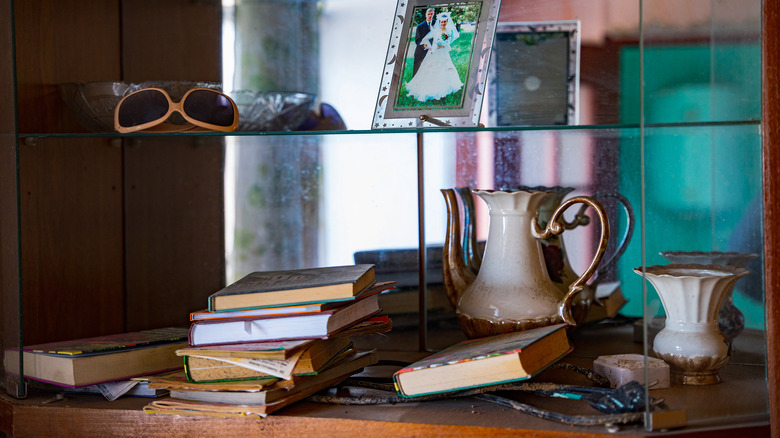Tsundoku Is The Bookish Japanese Decorating Practice You May Already Be Doing
There's something about unread books that piques our curiosity -– stirring up some latent desire to adventure into worlds unbeknownst to us. Being an avid reader isn't a prerequisite for this feeling. It's merely a matter of appreciating the possibilities. Perhaps that mentality drives the desire to accumulate stacks of books we haven't gotten around to reading yet.
Created by combining tsunde-oku, the Japanese word for letting things pile up, and dokusho, which translates to reading, tsundoku is a Japanese term used to describe the pile of literature you've acquired but haven't actually read (per Big Think). First appearing in print at the turn of the 20th century, it was used to poke fun at a teacher with an impressive collection of books and little knowledge of their contents. Today, however, the word has lost its bite, no longer implying fraudulence.
Instead, those who have dedicated themselves to the assembly of an aspirational library filled with soon-to-be-read books – stacked with care on every available surface — have begun wearing the word like a badge of honor. As if, at last, a name has been given to a great love that even the most well-read could never aptly describe. The identifier gives way to a secret society of sorts, differentiating us from bibliomaniacs who collect books for the sake of possession rather than the desire to know. Because anyone who practices tsundoku believes with all their heart that for every unread title in their collection, there's a "someday."
Tsundoku for self betterment
Tsundoku, as a concept, has been given other names as well. In his book "The Black Swan: The Impact of the Highly Improbable," essayist and statistician Nassim Nicholas Taleb labeled personal collections of unread literature as an "antilibrary" (per New York Times). While this name conjures more dystopian visions than its Japanese counterpart, the sentiment remains the same: The stacks of books we acquire with the intention of reading are a humble acknowledgment of our limited knowledge and a declaration of our intention to keep learning.
In support of this idea, a 2019 study published in Social Science Research discovered that children who were raised in a home filled with books grew up to be adults with improved literacy, numeracy, and information and communication technology (ICT) skills. So, if children who are surrounded by books they have not yet read are inspired to be more learned adults, perhaps the same goes for learned adults with the evergreen desire to be better, to know more, and to relate more deeply to the world around them.
Tsundoku for style
In addition to the potential for self-betterment, practicing tsundoku doubles as a rather enchanting design tactic. For bookworms with too many titles and no place to put them, tsundoku-inspired decorating is a no-brainer! Still, even those who aren't as bookish can enjoy the cozy tranquility of a room full of books without a hefty price tag, thanks to the low cost of used books.
Aside from the obvious aesthetic allure, one of the beauties of tsundoku is that it doesn't require a lot of space. While many of us don't have room for a home library — let alone a sizable bookshelf — the art of tsundoku inspires you to see any surface as a potential place for books to live. That space between the armchair and the wall that could never quite fit a side table suddenly presents itself as the perfect place for books. The countless coffee table books you've acquired without a coffee table to put them on can quite literally become the coffee table if you stack them just so.
Many interior design pros encourage tsundoku enthusiasts to arrange books both vertically and horizontally as a way to enhance visual interest. When it comes to organizing the books, the story is yours to write. Whether an alphabetical arrangement ensures you can easily find a title once you're finally called to read it, or color coding is more your jam, however, you stack it, tsundoku adds an eclectic flare to any room.


